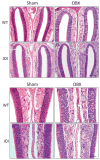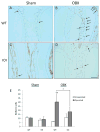Tumor necrosis factor alpha inhibits olfactory regeneration in a transgenic model of chronic rhinosinusitis-associated olfactory loss
- PMID: 21243089
- PMCID: PMC3021182
- DOI: 10.2500/ajra.2010.24.3498
Tumor necrosis factor alpha inhibits olfactory regeneration in a transgenic model of chronic rhinosinusitis-associated olfactory loss
Abstract
Background: Olfactory loss is a debilitating symptom of chronic rhinosinusitis (CRS). Although olfactory sensory neurons (OSNs) are normally regenerated constantly in the olfactory epithelium (OE), a transgenic model of CRS-associated olfactory loss (inducible olfactory inflammation [IOI] mouse) shows that inflammation causes widespread OSN loss without progenitor cell proliferation. In this study, we further examine whether the inflammatory cytokine tumor necrosis factor alpha (TNF-alpha) inhibits olfactory regeneration.
Methods: IOI mice underwent either unilateral bulbectomy or sham surgery and then were induced to express TNF-alpha in the OE for 1 week. After death, the mice were assessed histologically and with bromodeoxyuridine staining to determine the effect of TNF-alpha on olfactory regeneration.
Results: In the absence of TNF-alpha, bulbectomy was associated with death of OSNs, followed by robust proliferation of neural progenitors and regrowth of the OE. At 12 days postbulbectomy, OE thickness on the operated side had recovered to >80% of the unoperated side. In mice in which TNF-alpha expression was induced, significantly reduced proliferation was observed, associated with failure of normal reconstitution of OE thickness.
Conclusion: The mechanism of olfactory dysfunction in CRS remains incompletely understood. Previous studies with a transgenic mouse model suggested that inflammation inhibits progenitor cell proliferation and olfactory regeneration. Here, the role of the CRS-associated cytokine TNF-alpha was investigated using surgical ablation of the olfactory bulb to stimulate synchronous OSN turnover. We find that TNF-alpha expression prevents normal OE recovery, supporting the role of suppressed olfactory regeneration in the pathophysiology of CRS-associated olfactory loss.
Figures




Similar articles
-
Regulation of inflammation-associated olfactory neuronal death and regeneration by the type II tumor necrosis factor receptor.Int Forum Allergy Rhinol. 2013 Sep;3(9):740-7. doi: 10.1002/alr.21187. Epub 2013 Jun 3. Int Forum Allergy Rhinol. 2013. PMID: 23733314 Free PMC article.
-
The role of TNF-α in inflammatory olfactory loss.Laryngoscope. 2011 Nov;121(11):2481-6. doi: 10.1002/lary.22190. Epub 2011 Aug 31. Laryngoscope. 2011. PMID: 21882204 Free PMC article.
-
Reversible loss of neuronal marker protein expression in a transgenic mouse model for sinusitis-associated olfactory dysfunction.Am J Rhinol Allergy. 2010 May-Jun;24(3):192-6. doi: 10.2500/ajra.2010.24.3460. Am J Rhinol Allergy. 2010. PMID: 20537285 Free PMC article.
-
Structures and functions of the normal and injured human olfactory epithelium.Front Neural Circuits. 2024 Jun 6;18:1406218. doi: 10.3389/fncir.2024.1406218. eCollection 2024. Front Neural Circuits. 2024. PMID: 38903957 Free PMC article. Review.
-
Olfactory dysfunction in chronic rhinosinusitis: insights into the underlying mechanisms and treatments.Expert Rev Clin Immunol. 2023 Jul-Dec;19(8):993-1004. doi: 10.1080/1744666X.2023.2235891. Epub 2023 Jul 13. Expert Rev Clin Immunol. 2023. PMID: 37432663 Review.
Cited by
-
Regulation of inflammation-associated olfactory neuronal death and regeneration by the type II tumor necrosis factor receptor.Int Forum Allergy Rhinol. 2013 Sep;3(9):740-7. doi: 10.1002/alr.21187. Epub 2013 Jun 3. Int Forum Allergy Rhinol. 2013. PMID: 23733314 Free PMC article.
-
Patterns of olfactory dysfunction in chronic rhinosinusitis identified by hierarchical cluster analysis and machine learning algorithms.Int Forum Allergy Rhinol. 2019 Mar;9(3):255-264. doi: 10.1002/alr.22249. Epub 2018 Nov 28. Int Forum Allergy Rhinol. 2019. PMID: 30485725 Free PMC article.
-
Interferon gamma causes olfactory dysfunction without concomitant neuroepithelial damage.Int Forum Allergy Rhinol. 2013 Nov;3(11):861-5. doi: 10.1002/alr.21226. Epub 2013 Sep 17. Int Forum Allergy Rhinol. 2013. PMID: 24106006 Free PMC article.
-
International consensus statement on allergy and rhinology: Olfaction.Int Forum Allergy Rhinol. 2022 Apr;12(4):327-680. doi: 10.1002/alr.22929. Int Forum Allergy Rhinol. 2022. PMID: 35373533 Free PMC article. Review.
-
IL-1Rahigh-IL-4low-IL-13low: A Novel Plasma Cytokine Signature Associated with Olfactory Dysfunction in Older US Adults.Chem Senses. 2020 May 29;45(5):407-414. doi: 10.1093/chemse/bjaa029. Chem Senses. 2020. PMID: 32369568 Free PMC article.
References
-
- Loury KM. Chronic sinusitis and nasal polyposis. In: Getchell TV, Bartoshuk LM, Doty RL, Snow JB, editors. Smell and Taste in Health and Disease. New York: Raven Press; 1991. pp. 711–730.
-
- Kern RC. Chronic sinusitis and anosmia: Pathologic changes in the olfactory mucosa. Laryngoscope. 2000;110:1071–1077. - PubMed
-
- Kuehnemund M, Ismail C, Brieger J, et al. Untreated chronic rhinosinusitis: A comparison of symptoms and mediator profiles. Laryngoscope. 2004;114:561–565. - PubMed
-
- Lennard CM, Mann EA, Sun LL, et al. Interleukin-1 beta, interleukin-5, interleukin-6, interleukin-8, and tumor necrosis factor-alpha in chronic sinusitis: Response to systemic corticosteroids. Am J Rhinol. 2000;14:367–373. - PubMed
-
- Samanen DW, Forbes WB. Replication and differentiation of olfactory receptor neurons following axotomy in the adult hamster: A morphometric analysis of postnatal neurogenesis. J Compar Neurol. 1984;225:201–211. - PubMed
Publication types
MeSH terms
Substances
Grants and funding
LinkOut - more resources
Full Text Sources
Medical

